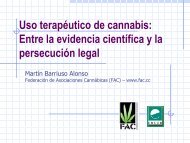Les Rencontres de Biarritz 2007 - THS 10
Les Rencontres de Biarritz 2007 - THS 10
Les Rencontres de Biarritz 2007 - THS 10
You also want an ePaper? Increase the reach of your titles
YUMPU automatically turns print PDFs into web optimized ePapers that Google loves.
VULNERABILITY TO BINGE DRINKING-RELATED BLACKOUTS<br />
AND VIOLENT IMPULSIVE BEHAVIOURS: DIFFERENTIAL KYNURENINE<br />
RESPONSE TO A TRYPTOPHAN LOAD.<br />
RÉSUMÉ / ABSTRACT<br />
VIGNAU J<br />
IMBENOTTE M<br />
DUROT C<br />
JACQUEMONT M-C<br />
DANEL T<br />
LIBERSA C<br />
VANDAMME M<br />
LHERMITTE M<br />
Aim: the study was <strong>de</strong>signed in the view of testing a mechanistic hypothesis that incriminates discrepancies in tryptophan 2,3-<br />
dioxygenase (TDO) activity in the enhanced vulnerability of certain individuals to experience repeated Blacked Out Violent<br />
Impulsive Behaviours (BOVIB) during binge drinking bouts.<br />
Methods: a tryptophan (Trp) oral load (50 mg/kg) was administered to a sample of treatment-seeking alcohol-<strong>de</strong>pen<strong>de</strong>nt<br />
patients. BOVIB history and psychological status were screened by BOVIB-Q, <strong>de</strong>pression (BDI), anxiety (BAI, STAI) and personality<br />
(TCI) questionnaires. During the 7 hours following Trp load, serum Kyn and Trp were monitored together with urinary cumulative<br />
excretion of 5HT metabolite 5 hydroxy-indoleacetic acid (5HIAA).<br />
Results: Reported BOVIB were all related to binge drinking pattern of alcohol use. Patients with a history of BOVIB (BOVIB +<br />
sub-group) differed from those exempt from such episo<strong>de</strong>s (BOVIB – sub-group) for TDO activity response to Trp oral load,<br />
assessed by the slope of concentration increase ratio (SCIR) of serum Kyn (p=.017) and for BDI (p=.003) and STAI-T (p=.001)<br />
scores. On total sample, linear regressions confirmed significant correlations between Kyn SCIR and both BDI and STAI-T scores<br />
and between BDI scores and TCI pathological personality scores. Besi<strong>de</strong>s, interesting (though non significant) correlation was<br />
found between Kyn SCIR and 5HIAA excretion.<br />
Conclusion: Put together, these findings corroborate the consistency of the clinical entity BOVIB and its therapeutic importance<br />
in differentiating a particular sub-group of biologically vulnerable alcohol-<strong>de</strong>pen<strong>de</strong>nt subjects.<br />
But : notre étu<strong>de</strong> est a été construite dans le but <strong>de</strong> tester une hypothèse <strong>de</strong> mécanisme neurobiologique sous-tendant la vulnérabilité<br />
<strong>de</strong> certains individus à présenter <strong>de</strong>s ivresses pathologiques ou IP (conduites impulsives violentes suivies d’amnésie<br />
<strong>de</strong>s faits) lors <strong>de</strong> prises aiguës d’alcool (« binges »). Cette hypothèse repose sur l’existence <strong>de</strong> variations <strong>de</strong> l’activité <strong>de</strong> la<br />
2,3-tryptophane-dioxygénase (TDO), une enzyme impliquée dans la synthèse <strong>de</strong> la kynurénine.<br />
Métho<strong>de</strong> : une dose <strong>de</strong> charge <strong>de</strong> tryptophane ou Trp (50mg/kg) a été administrée chez <strong>de</strong>s patients alcoolo-dépendants<br />
accueillis en service hospitalier d’addictologie pour un sevrage d’alcool. <strong>Les</strong> antécé<strong>de</strong>nts d’IP et l’état psychologique <strong>de</strong>s<br />
patients ont été évalués par divers questionnaires tels qu’une échelle d’auto-évaluation <strong>de</strong>s IP, les questionnaires <strong>de</strong> Beck pour<br />
la dépression (BDI) et pour l’anxiété (BAI), le questionnaire <strong>de</strong> Spielberger (STAI) et le questionnaire <strong>de</strong> Cloninger (TCI). Dans<br />
les 7 heures suivant l’administration <strong>de</strong> la dose <strong>de</strong> charge en Trp, divers paramètres biologiques ont été mesurés : cinétique<br />
<strong>de</strong>s taux sériques <strong>de</strong> kynurénine (pente d’accroissement <strong>de</strong> la concentration ou PAC) et <strong>de</strong> Trp, excrétion urinaire du principal<br />
métabolite <strong>de</strong> la sérotonine (aci<strong>de</strong> 5-OH-indole-acétique).<br />
Résultats : <strong>Les</strong> IP rapportées par les patients entraient toutes dans le cadre <strong>de</strong> prises aiguës d’alcool. <strong>Les</strong> patients alcoolodépendants<br />
ayant présenté <strong>de</strong>s IP (IP+) diffèrent <strong>de</strong> ceux qui n’en ont jamais présenté (IP-) en ce qui concerne la PAC <strong>de</strong> la<br />
kynurénine sérique (reflétant l’activité <strong>de</strong> la TDO) en réponse au test <strong>de</strong> charge en Trp (p=0,017) et les scores aux questionnaires<br />
BDI (p=0,003) et STAI-T (p=0,001). Sur l’échantillon total, les régressions linéaires ont confirmé <strong>de</strong>s corrélations significatives<br />
entre la PAC <strong>de</strong> kynurénine sérique et les scores <strong>de</strong> BDI et <strong>de</strong> STAI-T et entre les scores à la BDI et l’indice <strong>de</strong> personnalité<br />
pathologique au TCI. Par ailleurs, une corrélation non significative a été retrouvée entre la PAC <strong>de</strong> kynurenine<br />
sérique et la quantité totale <strong>de</strong> 5HIAA excrétée dans les urines.<br />
Conclusion : Si les IP font classiquement partie <strong>de</strong> la nosographie française, cette entité n’a pas reçu, jusqu’à présent, <strong>de</strong> validation<br />
<strong>de</strong> la part <strong>de</strong> la communauté scientifique anglo-saxonne. L’ensemble <strong>de</strong>s résultats préliminaires <strong>de</strong> notre étu<strong>de</strong> donne<br />
<strong>de</strong> la consistance à cette entité morbi<strong>de</strong>, tant sur le plan biologique que clinique. La reconnaissance <strong>de</strong> la vulnérabilité aux<br />
IP d’un sous-groupe <strong>de</strong> sujets alcoolo-dépendants a <strong>de</strong>s implications thérapeutiques importantes.<br />
Dr Jean VIGNAU<br />
Centre Hospitalier Universitaire – Service d’Addictologie 57, boulevard <strong>de</strong> Metz<br />
59037 Lille Ce<strong>de</strong>x, France<br />
Tel : +33 320 44 60 98 - Fax : +33 320 44 54 37<br />
j-vignau@chru-lille.fr<br />
163
















